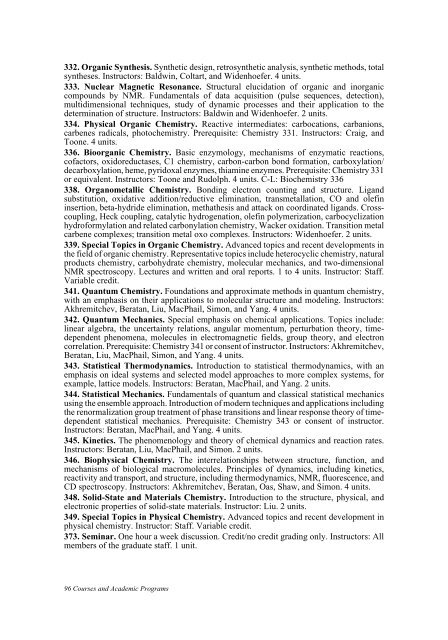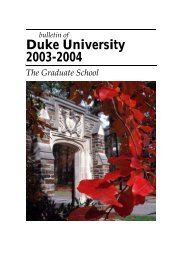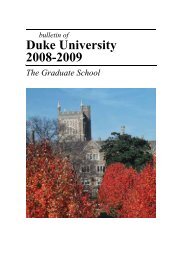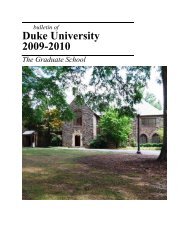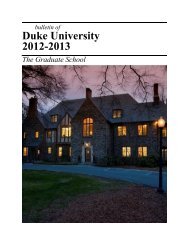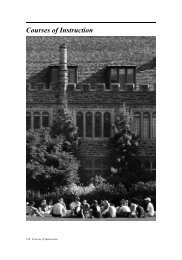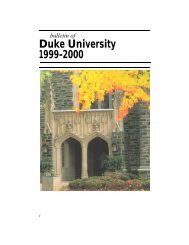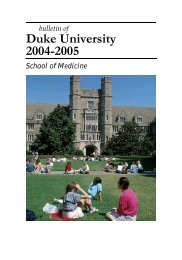2005-06 - Office of the Registrar - Duke University
2005-06 - Office of the Registrar - Duke University
2005-06 - Office of the Registrar - Duke University
You also want an ePaper? Increase the reach of your titles
YUMPU automatically turns print PDFs into web optimized ePapers that Google loves.
332. Organic Syn<strong>the</strong>sis. Syn<strong>the</strong>tic design, retrosyn<strong>the</strong>tic analysis, syn<strong>the</strong>tic methods, total<br />
syn<strong>the</strong>ses. Instructors: Baldwin, Coltart, and Widenhoefer. 4 units.<br />
333. Nuclear Magnetic Resonance. Structural elucidation <strong>of</strong> organic and inorganic<br />
compounds by NMR. Fundamentals <strong>of</strong> data acquisition (pulse sequences, detection),<br />
multidimensional techniques, study <strong>of</strong> dynamic processes and <strong>the</strong>ir application to <strong>the</strong><br />
determination <strong>of</strong> structure. Instructors: Baldwin and Widenhoefer. 2 units.<br />
334. Physical Organic Chemistry. Reactive intermediates: carbocations, carbanions,<br />
carbenes radicals, photochemistry. Prerequisite: Chemistry 331. Instructors: Craig, and<br />
Toone. 4 units.<br />
336. Bioorganic Chemistry. Basic enzymology, mechanisms <strong>of</strong> enzymatic reactions,<br />
c<strong>of</strong>actors, oxidoreductases, C1 chemistry, carbon-carbon bond formation, carboxylation/<br />
decarboxylation, heme, pyridoxal enzymes, thiamine enzymes. Prerequisite: Chemistry 331<br />
or equivalent. Instructors: Toone and Rudolph. 4 units. C-L: Biochemistry 336<br />
338. Organometallic Chemistry. Bonding electron counting and structure. Ligand<br />
substitution, oxidative addition/reductive elimination, transmetallation, CO and olefin<br />
insertion, beta-hydride elimination, metha<strong>the</strong>sis and attack on coordinated ligands. Crosscoupling,<br />
Heck coupling, catalytic hydrogenation, olefin polymerization, carbocyclization<br />
hydr<strong>of</strong>ormylation and related carbonylation chemistry, Wacker oxidation. Transition metal<br />
carbene complexes; transition metal oxo complexes. Instructors: Widenhoefer. 2 units.<br />
339. Special Topics in Organic Chemistry. Advanced topics and recent developments in<br />
<strong>the</strong> field <strong>of</strong> organic chemistry. Representative topics include heterocyclic chemistry, natural<br />
products chemistry, carbohydrate chemistry, molecular mechanics, and two-dimensional<br />
NMR spectroscopy. Lectures and written and oral reports. 1 to 4 units. Instructor: Staff.<br />
Variable credit.<br />
341. Quantum Chemistry. Foundations and approximate methods in quantum chemistry,<br />
with an emphasis on <strong>the</strong>ir applications to molecular structure and modeling. Instructors:<br />
Akhremitchev, Beratan, Liu, MacPhail, Simon, and Yang. 4 units.<br />
342. Quantum Mechanics. Special emphasis on chemical applications. Topics include:<br />
linear algebra, <strong>the</strong> uncertainty relations, angular momentum, perturbation <strong>the</strong>ory, timedependent<br />
phenomena, molecules in electromagnetic fields, group <strong>the</strong>ory, and electron<br />
correlation. Prerequisite: Chemistry 341 or consent <strong>of</strong> instructor. Instructors: Akhremitchev,<br />
Beratan, Liu, MacPhail, Simon, and Yang. 4 units.<br />
343. Statistical Thermodynamics. Introduction to statistical <strong>the</strong>rmodynamics, with an<br />
emphasis on ideal systems and selected model approaches to more complex systems, for<br />
example, lattice models. Instructors: Beratan, MacPhail, and Yang. 2 units.<br />
344. Statistical Mechanics. Fundamentals <strong>of</strong> quantum and classical statistical mechanics<br />
using <strong>the</strong> ensemble approach. Introduction <strong>of</strong> modern techniques and applications including<br />
<strong>the</strong> renormalization group treatment <strong>of</strong> phase transitions and linear response <strong>the</strong>ory <strong>of</strong> timedependent<br />
statistical mechanics. Prerequisite: Chemistry 343 or consent <strong>of</strong> instructor.<br />
Instructors: Beratan, MacPhail, and Yang. 4 units.<br />
345. Kinetics. The phenomenology and <strong>the</strong>ory <strong>of</strong> chemical dynamics and reaction rates.<br />
Instructors: Beratan, Liu, MacPhail, and Simon. 2 units.<br />
346. Biophysical Chemistry. The interrelationships between structure, function, and<br />
mechanisms <strong>of</strong> biological macromolecules. Principles <strong>of</strong> dynamics, including kinetics,<br />
reactivity and transport, and structure, including <strong>the</strong>rmodynamics, NMR, fluorescence, and<br />
CD spectroscopy. Instructors: Akhremitchev, Beratan, Oas, Shaw, and Simon. 4 units.<br />
348. Solid-State and Materials Chemistry. Introduction to <strong>the</strong> structure, physical, and<br />
electronic properties <strong>of</strong> solid-state materials. Instructor: Liu. 2 units.<br />
349. Special Topics in Physical Chemistry. Advanced topics and recent development in<br />
physical chemistry. Instructor: Staff. Variable credit.<br />
373. Seminar. One hour a week discussion. Credit/no credit grading only. Instructors: All<br />
members <strong>of</strong> <strong>the</strong> graduate staff. 1 unit.<br />
96 Courses and Academic Programs


